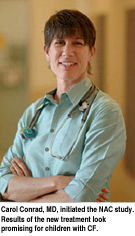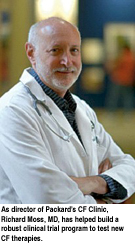Pediatric Pulmonary Research
Translational medicine is all about moving therapies from the research laboratory to the patient. Making that transition happen is a major focus of the Center for Pulmonary Biology at Lucile Packard Children's Hospital. One of the most active areas for translational medicine within the Center is at the CF Clinic, where a robust clinical trial program usually has around 10 to 15 trials going on at any one time.
Richard Moss, MD, director of Packard's CF Clinic, has devoted much of his energy over the years to developing therapies for cystic fibrosis, a disease that most often strikes children when they are quite young. The life expectancy of CF patients has been substantially extended in recent years owing to research that has led to better anti-infective drugs, earlier diagnosis, and improved understanding of nutritional needs. A crucial step in getting new therapies spawned by scientific discoveries to patients is the clinical trial. Moss has participated in many trials over the years and is especially optimistic about one now underway of a treatment developed at the CF Clinic, in partnership with the Herzenberg Lab in the Department of Genetics at the Stanford University School of Medicine.
The medication under study is called NAC, short for N-acetyl cysteine, and has been used successfully in treating a number of diseases including HIV/AIDS and pulmonary fibrosis, which scars the lungs. NAC had been tried with CF patients as an inhalant 20 years ago, in hopes it would help break up the thick mucus generated by CF and make it easier for patients to cough and clear their lungs. It didn't help, so the treatment was abandoned. But the current trial, which was initiated by Packard pulmonologist Carol Conrad, MD, has been testing the effectiveness of high oral doses in reducing mucus production and lung inflammation with considerable success.
A Vicious Cycle
 Lung infections and the resulting inflammation are a persistent problem for CF patients, with the inflammation opening the door for additional infections to take hold. "It's a vicious cycle of inflammation and infection," says Zoe Davies, PNP, pulmonary nurse practitioner and research coordinator.
Lung infections and the resulting inflammation are a persistent problem for CF patients, with the inflammation opening the door for additional infections to take hold. "It's a vicious cycle of inflammation and infection," says Zoe Davies, PNP, pulmonary nurse practitioner and research coordinator.
One reason inflammation is such a problem in CF is that the white blood cells that combat inflammation are missing a critical ingredient, an antioxidant protein called glutathione, the lack of which renders them ineffective. The body tries to compensate for that deficit by producing even more white blood cells, which only inflames the lungs further. NAC provides the basic building block for production of glutathione, thereby helping to quell the cycle.
Conrad says NAC reduced the white blood cell count in the sputum of the patients by up to 40 percent. "[The patients] all said they felt better, that their mucus was easier to cough up, that there was less of it, that they had more energy," says Conrad. "A few of them complained of a little bit of heartburn but it went away after a few days," she adds.
FACS Technology
 To assess how well the NAC was working, Conrad collaborated with geneticists Lenore Herzenberg, PhD, and Leonard Herzenberg, PhD, and research associate Rabindra Tirouvanziam, PhD, at Stanford. The group uses a sophisticated instrument called a Fluorescence Activated Cell Sorter (FACS), which is used in monitoring many different diseases because it can reveal the sometimes subtle changes occurring on a molecular level.
To assess how well the NAC was working, Conrad collaborated with geneticists Lenore Herzenberg, PhD, and Leonard Herzenberg, PhD, and research associate Rabindra Tirouvanziam, PhD, at Stanford. The group uses a sophisticated instrument called a Fluorescence Activated Cell Sorter (FACS), which is used in monitoring many different diseases because it can reveal the sometimes subtle changes occurring on a molecular level.
"The FACS is extremely valuable in that it allows us to get a huge amount of information from tiny samples of sputum from a patient's lungs," says Conrad, adding that without it, determining the changes occurring due to the NAC treatment would be quite difficult. "The current leading edge of very sophisticated FACS technology is really only available at Stanford," says Moss.
The technology was created by Leonard Herzenberg, who was recently awarded the Japanese equivalent of the Nobel Prize for the development of FACS.
Collaborations Speed Progress
Partnerships such as the one with the Herzenberg Lab are a vital component of the effort to move therapies from theory into use with patients. "The Center for Pulmonary Biology is really based on the idea that the research should be very broad and interdisciplinary," says Moss, adding that the ability to engage in those kinds of collaborations at Stanford is one of the great strengths of the Clinic. When researchers with a wide range of specialties can join forces to develop a therapy for a disease, it can make a huge difference in speeding the work to the stage where it can help sick children.
The potential for that sort of cross fertilization of ideas is precisely what lured David Cornfield, MD, director of the Center, to Packard Hospital. "The sort of confluence that goes on between the clinical and the research arenas here is perfectly well matched for the sort of care that goes on in CF related disease," says Cornfield, whose own research focuses on pulmonary hypertension.
The NAC researchers are hopeful that because this medication has been approved to treat other diseases, much is already known about it, which may ease the way for a relatively rapid trip from trials to the children who need it. "We hope to move quickly to a large, multi-center study and perhaps offer it as a new treatment for cystic fibrosis," Moss says.

